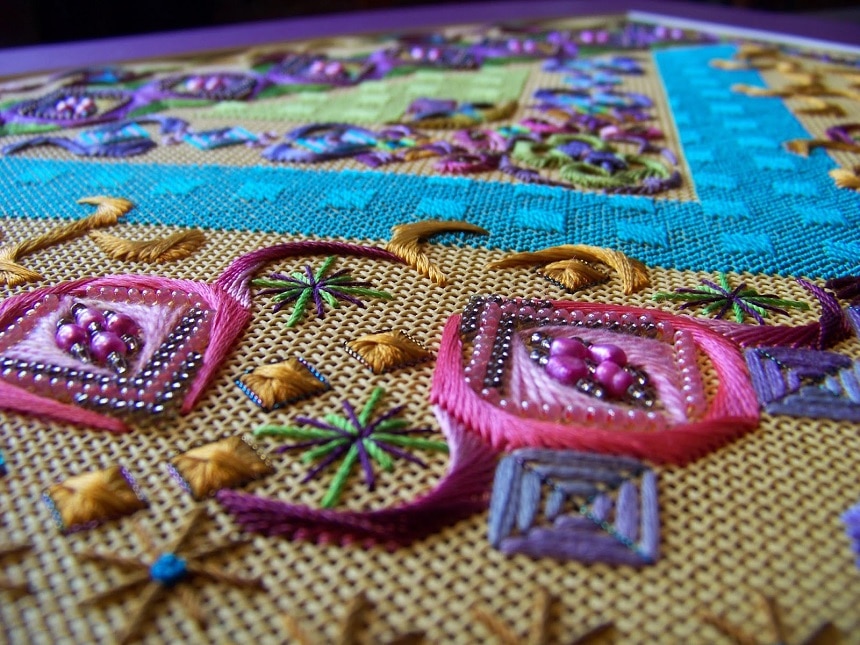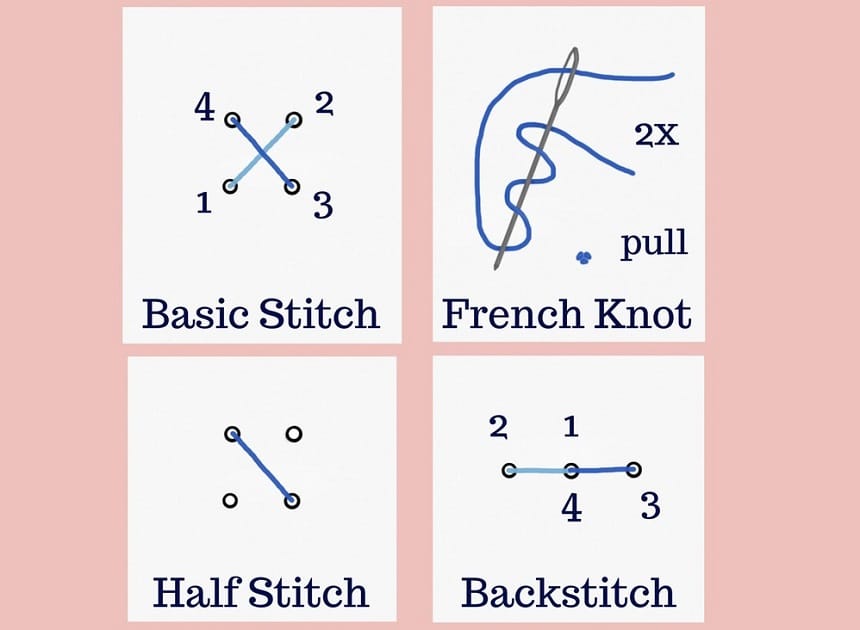

Crafts done with a thread, needle, and cloth have been on a steady rise for a while. They have also evolved big time. These crafts are generally referred to as needlework. All you need is a needle, yarn, or colored floss to stitch then you can let your creative mind loose to make the impossible. There are different styles and ways of doing needlework, and they include; embroidery, needlepoint, cross-stitch, and plastic canvas, among others.
All these art forms involve the use of similar materials, hence the famous needlepoint vs. cross stitch debate. The 2 are also often confused with embroidery. To make the best use of each of the crafts, you have to know their differences and similarities. Needlepoint is a surface embroidery done on very fine canvas, while cross-stitch is an embroidery technique that utilizes x-shaped stitches to form a larger picture.
Needlepoint is a surface embroidery that is popularly used to decorate accessories like belts, wall hangings, and jewelry. It originates from ancient Egypt and is mostly done on super-fine canvas with yarn. You can also use strands of embroidery floss to achieve a different look.
Needlepoint is stitched by hand, and it allows the use of various stitches. It can also include beading.

Needlepoint has myriad stitch types, including:
This is the sturdiest stitch, and it is done vertically or horizontally across a fabric.
The cushion stitches are made of 5 diagonal stitches, with the longest in the middle and the shorter ones following it.
This is created in diagonal rows and is mostly used over large areas.
These include three stitches, with the longest one in the middle and the shorter ones surrounding it.
This is similar to a tent stitch done across the fabric either vertically or horizontally.
This is basically the basketweave stitch pattern with shorter parallel stitches.
This is a slanting diagonal stitch created over 2 horizontal threads and 1 vertical thread.
Stiff and heavy but very fine canvas is the most common type of fabric used for needlepoint. Some craft stores stock needlepoint fabric with patterns already printed on them, but if you want to personalize your designs, you can opt for a blank canvas.
A cross stitch is basically a hand embroidery that uses x-shaped stitches. When done correctly, the stitches form a pattern that looks like a tile. Cross stitch only allows the use of one stitch, but you can use ½, ¼, and ¾ cross stitches to create a pattern.
Another noteworthy thing about cross stitch is that it is not as fluid as regular embroidery. It has more of a box-like appearance. For this reason, it is mostly used for framed artworks and making bookmarks, coasters, or any other one-sided objects that allow hiding of the pattern’s backside.

Cross stitch only allows the use of a single stitch, but you can use partial stitches to shape and add texture to your work and backstitch Trusted Source Backstitch - Wikipedia Backstitch or back stitch and its variants stem stitch, outline stitch and split stitch are a class of embroidery and sewing stitches in which individual stitches are made backward to the general direction of sewing. en.wikipedia.org to create small details and outlines.
The most common materials used for cross stitch include; canvas, linen cloth, and floss. Aida cloth is also a famous go-to for many embroiders because it has uniform holes that create similar x-stitches throughout the pattern much easier.
Needlepoint is a type of surface embroidery that is worked on very fine canvas, while the cross stitch is a type of hand embroidery that uses X-shaped stitches.
Needlepoint is worked on canvas that is much stiffer and heavier with more holes, while cross-stitch is done on evenly woven fabric or Aida cloth.
Needlepoint involves the tent stitch and allows the use of different types of stitches, while cross-stitch involves a type of stitch that intersects to form an X.
You can use various stitches over the base canvas layer with needlepoint, while with the cross-stitch, you can only cover the base canvas.
Needlepoint has multiple types of stitches, while cross stitch only has the full cross stitch, partial stitches (1/2, ¼, ¾ ), and the backstitch.
Embroidery refers to the craft of decorating fabric or any other materials using thread or yarn and needles. It is the general term that encompasses cross stitch, needlepoint, and any other craft that involves the use of needle and thread.
Embroidery can be done by machines or by hand. Machine embroidery is pretty easy as designs are created by an embroidery software, which then instructs an embroidery machine to embroider fabric designs. It is mostly used for mass production of embroidered items like clothes and home décor stuff.
Hand embroidery involves creating designs on fabric and similar materials using hands. Needlepoint and cross-stitch fall under this category. You can achieve more unique and personalized designs with hand embroidery because, unlike machine embroidery, it allows you to explore your creativity rather than rely on pre-programmed designs.
However, you must have some great skills to make embroidered items as neat as the ones made by machines using your hands. It also takes more time.
The bottom line is cross stitch and needlepoint are just two types of hand embroidery that anyone can enjoy, provided you have the required tools. If you are a beginner, it is recommended that you buy an embroidery kit for the particular craft you are interested in to get the most value for your money.
For instance, if you want to make framed artwork or coasters with cross-stitch, consider buying a cross stitch kit. According to most reviews, the Caydo Full Range of Embroidery Starter Kit is one of the most valuable sets that money can buy. It has nearly everything you need for embroidery.
With all the hints and pointers in this article, you cannot be part of the needlepoint vs. cross stitch or needlepoint vs. embroidery confusion. You should be able to tell the difference between cross stitch and needlepoint and pick one for your most coveted pixel art. Once you can tell the crafts apart, you can make the most with each of them, provided you have the best fabric for embroidery, thread, and needles.
If you are a beginner, be sure to get a good embroidery starter pack like the highly praised DIMENSIONS Old Mill Cottage Needlepoint Kit. It is a whole valuable package that comes with cotton thread, a needle, 14 full color printed mesh canvas, and instructions to help you get it right. If you are totally green on embroidery, then you can use some tips to get started until you become a pro.